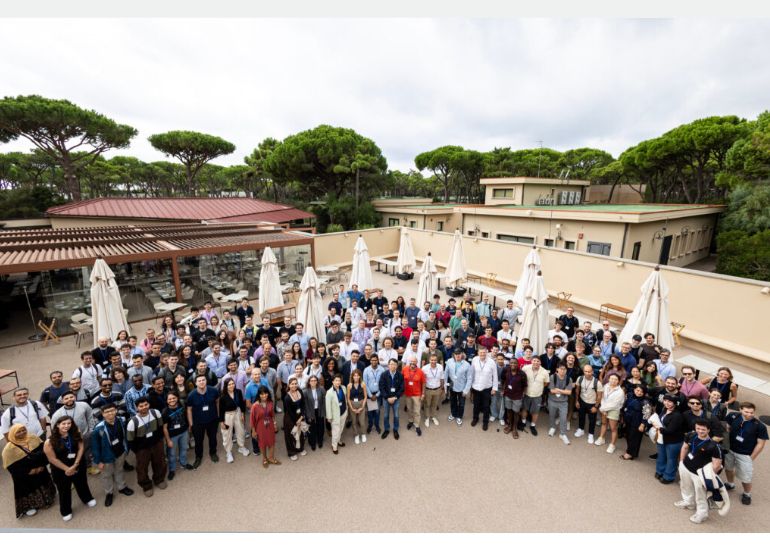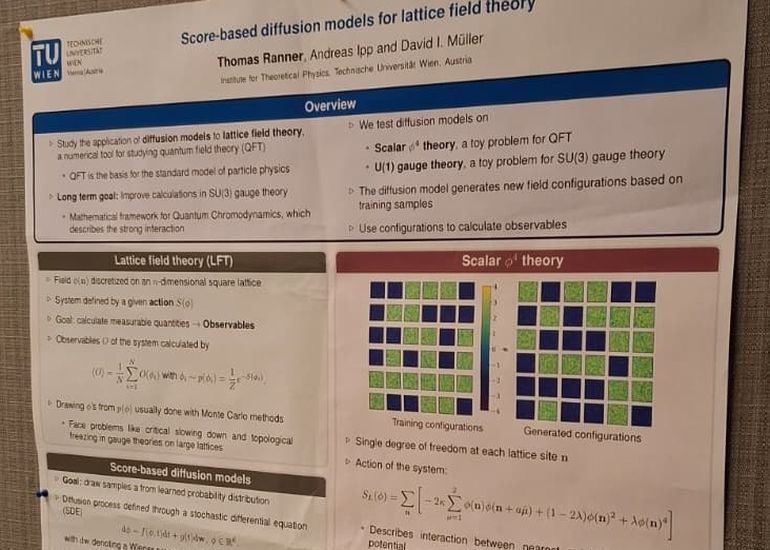Thomas Ranner presents “Score-based diffusion models for lattice Theory”
Poster presentation at IAISS 2025.

September 21st – 25th 2025
- All day event.
iCAIML PhD student Thomas Ranner presented “Score-based diffusion models for lattice Theory” at the International Artificial Intelligence Summer School – IAISS 2025 on September 21-25, 2025.

Abstract
Score-based diffusion models are generative deep learning models that have been highly successful, especially in the field of image generation. While they are inspired by a physical process, the diffusion, they were not designed with applications in physics in mind. However, recently their potential for application in theoretical physics, specifically in lattice field theory, has been demonstrated. Lattice field theory (LFT) is a numerical tool which is essential for many numerical calculations in quantum field theory (QFT). Quantum field theory is the framework in which the standard model of particle physics is formulated, which is our current best understanding of the fundamental particles and interactions (except for gravity). For LFT, the fields of QFT are discretized in space and time and put onto a lattice. Probability distributions of those discrete field configurations are known, and to calculate physical observables of the field theory one has to sample a large number of field configurations according to these distributions. This computationally very intensive task is usually done with Monte Carlo methods. These face problems, especially when going to larger lattices, which may make calculations intractable. Inspired by the analogous data structures of two-dimensional lattices and images, one can instead use modern image generation methods. Score-based diffusion models have recently been successfully applied to scalar field theory, a theory with a single scalar degree of freedom at each lattice site.
In our work, we further investigated score-based diffusion models in the context of scalar field theory and also applied them to U(1) lattice gauge theory. We found that the results of the diffusion model for scalar field theory are almost perfect, while for U(1) gauge theory there were some problems when going to a parameter regime of the theory which is especially hard to sample from. Very recently, a group, with which we now also collaborate, has found a workaround to this problem by introducing a new generative diffusion process. It is based on the fact that the score (which is what the neural network learns) in score-based diffusion models corresponds to the negative gradient of the action (an important physical quantity describing the theory) of the LFT. We also used this correspondence by integrating physical knowledge into the network design and were able to achieve a significant speed-up of the training process. Furthermore, by adapting the diffusion model such that the network learns not the gradient of the action, but the action itself, we were also able to decrease the number of necessary training steps, though each training step became more costly. Still, as the action is a quantity of interest in physics, this may have further applications. For example, one could determine the action of an experimental system which is only accessible by measurements of field configurations. Another avenue we started to explore is to use networks trained at a certain lattice size to generate configurations on bigger lattices. While the theories we studied until now can still be properly covered by traditional numerical methods, we are confident that diffusion models have a huge potential in more involved theories. In this spirit, we just started a collaboration where we aim to apply score-based diffusion models to more complex non-abelian theories such as SU(2) gauge theory. We hope that the integration of deep learning techniques will enable us to massively improve upon existing calculations in lattice field theory.

